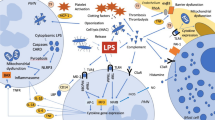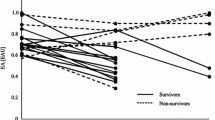Abstract
The Limulus amoebocyte lysate assay was used as one of a series of laboratory and clinical investigations on a group of 31 patients suffering from septic shock in order to assess the clinical significance of this assay for the detection of circulating endotoxin in clinical gram-negative sepsis. Four patients with cardiogenic shock served as controls. Endotoxin was detected in the bloodstream of all patients with septic shock during the 24 h following referral and was not detected in the control patients. Eventual clinical recovery was associated with the disappearance of endotoxin from the peripheral blood. Blood cultures were unhelpful as a prognostic indicator in these critically ill patients. A quantitative assay of endotoxin in blood may allow a more precise relationship with the clinical manifestations of major sepsis.
Similar content being viewed by others
References
Bailey ME (1976) Endotoxin, bile salts and renal function in instructure jaundice. Br J Surg 63:774
Clements GB (Unpublished observations)
Du Bose DA, Le Maire M, Basamania K, Rowlands J (1980) Comparison of plasma extraction techniques in preparation of samples for endotoxin testing by the Limulus amoebocyte lysate test. J Clin Microbiol 11:68
elin RJ (1979) Clinical utility of the Limulus test with blood, CSF and synovial fluid. In: Cohen E (ed) Biomedical applications of the Horseshoe Crab (Limulidae). Alan R Liss, New York, p 279
Fossard DP, Kakkar VV (1976) The Limulus test in experimental and clinical endotoxaemia. Br J Surg 61:798
Fossard DP, Kakkar VV, Elsey Penelope A (1974) Assessment of limulus test for detecting endotoxaemia. Br Med J 61:465
Goto H, Nakamura S (1980) Liberation of endotoxin fromEscherichia coli by addition of antibiotics. Japan J Exp Med 50:35
Iwanaga S, Morita T, Harada T, Nakamura S, Niwa M, Takada K, Kimura T, Sakakibara S (1978) Chromogenic substrates for horseshoe crab clotting enzyme — its application for the assay of bacterial endotoxins. Haemostasis 7:183
Jacob AI, Goldberg PK, Bloom N, Degenshein GA, Kozim PJ (1977) Endotoxin and bacterial in portal blood. Gastroenterology 72:1268
Ledingham IMcA, Bradley JA, McCartney AC, Redding PJ (1983) Infection and septic shock. In: Bain WH, Taylor KM (eds) Handbook of intensive care. John Wright, London (in press)
Ledingham IMcA, McArdle CS (1978) Prospective study of the treatment of septic shock. Lancet 1:1194
Levin J (1979) The Limulus test: a status report. In: Cohen E (ed) Biomedical applications of the Horseshoe Crab (Limulidae). Alan R Liss, New York, p 235
Levin J, Tomasulo PA, Oser RS (1970) Detection of endotoxin in human blood and demonstration of an inhibitor. J Lab Clin Med 75:903
Lucie NP, Browning JD, Smillie DM, Ledingham IMcA (1980) Platelet count and other haematological measurements in septic shock. J Clin Pathol 33:890
McGovern VJ (1972) The pathophysiology of gram-negative shock. Pathol 4:265
Nakamura S, Morita S, Iwanaga M, Niva M, Takahashi K (1977) A sensitive substrate for the clotting enzyme in horseshoe crab haemocytes. J Biochem (Tokyo) 81:1567
Reinhold RB, Fine J (1971) A technique for quantitative measurement of endotoxin in human plasma. Proc Soc Exp Biol Med 137:334
Scovill WA, Saba TM, Blumenstock FA, Bernard H, Powers SR (1978) Opsonic α2 surface binding glycoprotein therapy during sepsis. Ann Surg 188:521
Scully MF, Newman YM, Clark SE, Kakkar VV (1980) Evaluation of a chromogenic method for endotoxin measurement. Thromb Res 20:263
Siegel SE, Nachum R (1977) Use of the Limulus lysate assay (LAL) for the detection and quantitation of endotoxin. In: Bernheimer AW (ed) Perspectives on toxinology. John Wiley, New York, p 61
Sim AJW, McCartney A Christine (1980) The appearance of endotoxin following urethral instrumentation. Br J Surg 67:443
Sullivan JD Jr, Valois FW, Watson SW (1976) Endotoxins: the limulus amoebocyte lysate system. In: Bernheimer AW (ed) Mechanisms in bacterial toxinology. John Wiley, New York p 217
Wiles JB, Cerra FB, Siegel JH, Border JR (1980) The systemic septic response: does the organism matter? Crit Care Med 8:55
Wilkinson SP, Moodie H, Stamatakis JD, Kakkar VV, Williams R (1976) Endotoxaemia and renal failure in cirrhosis and obstructive jaundice. Br Med J 2:1415
Author information
Authors and Affiliations
Rights and permissions
About this article
Cite this article
McCartney, A.C., Banks, J.G., Clements, G.B. et al. Endotoxaemia in septic shock: Clinical and post mortem correlations. Intensive Care Med 9, 117–122 (1983). https://doi.org/10.1007/BF01772577
Accepted:
Issue Date:
DOI: https://doi.org/10.1007/BF01772577




